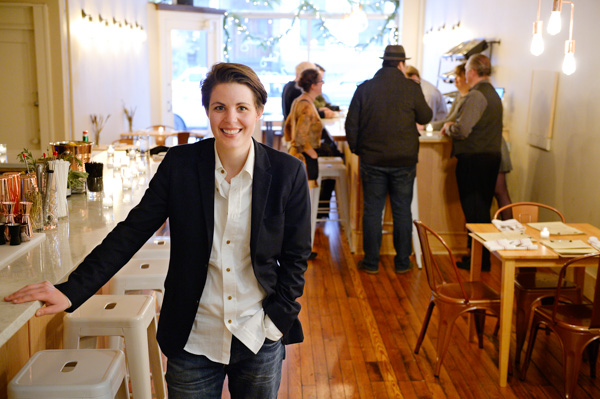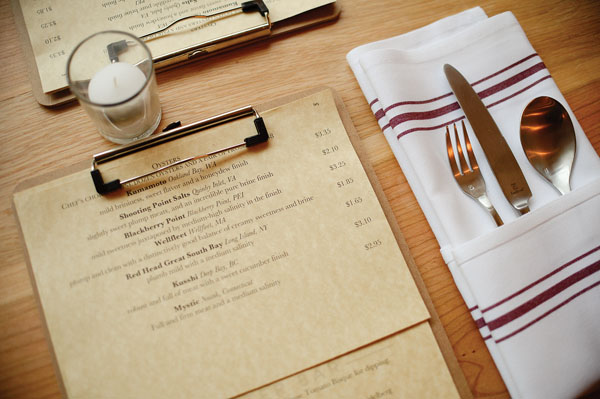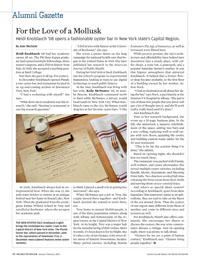Alumni Gazette
 THE NEW OYSTER CULT: Knoblauch (above) brings the contemporary oyster craze to the Capital District of New York state. The
Plumb Oyster Bar, which opened in December, adds to the rejuvenation of downtown Troy. A December menu (below) features seven
oyster varieties. (Photo: Jessica Hill/AP Images for Rochester Review)
THE NEW OYSTER CULT: Knoblauch (above) brings the contemporary oyster craze to the Capital District of New York state. The
Plumb Oyster Bar, which opened in December, adds to the rejuvenation of downtown Troy. A December menu (below) features seven
oyster varieties. (Photo: Jessica Hill/AP Images for Rochester Review)Heidi Knoblauch ’08 had her academic career all set. The Phi Beta Kappa graduate had earned multiple fellowships, three master’s degrees, and a PhD in history from Yale. In 2015, she accepted a teaching position at Bard College.
And then she gave it all up. For oysters.
In December Knoblauch opened Plumb, a raw oyster bar and restaurant located in an up-and-coming section of downtown Troy, New York.
“I had a reckoning with myself,” she says.
“What drew me to academia was the research,” she said. “Starting (a restaurant) is one big research question.”
In truth, Knoblauch always had an entrepreneurial bent. When she was 12, she sold water bottles to visitors at an antique festival near her home in Round Lake, New York. Then she graduated from the prestigious Emma Willard School in Troy and enrolled at Rochester, where she set upon her academic path.
“I fell in love with history at the University of Rochester,” she says.
 (Photo: Jessica Hill/AP Images for Rochester Review)
(Photo: Jessica Hill/AP Images for Rochester Review)She wrote a senior thesis on the long campaign for national health care that began in the United States in 1945. She later published her research in the American Journal of Public Health.
During her brief stint at Bard, Knoblauch ran the school’s program in experimental humanities, looking at ways to use digital technology to teach public history.
At the time, Knoblauch was living with her wife, Kelly McNamee ’05, in nearby Beacon. Knoblauch commuted north to Bard while McNamee, a lawyer, would head south to New York City. When Knoblauch came to the city, McNamee would drag her to her favorite oyster bars. “I like to think I played a small role in getting her interested,” she says.
When McNamee got a job in Troy, the couple moved there together—and Knoblauch decided she wanted to work there, too.
Troy, home to around 50,000 people, is one of the three population centers, along with Albany and Schenectady, of the region known as the Capital District of New York. At its height, Troy was a major hub for the manufacturing of shirt collars. More recently, it’s been known for its blight. But it’s also a city of rare beauty, with street after street of historic brownstone facades. Many period movies, including Martin Scorsese’s The Age of Innocence, as well as Ironweed, were filmed here.
While poverty persists, the city’s architecture and affordability have helped turn downtown into a trendy place, with coffee shops, a wine bar, a gastropub, and a popular Saturday farmer’s market. It was this hipster atmosphere that attracted Knoblauch. It helped that a former flower shop became available, in the first floor of a building owned by her mother, Arlene Nock.
“I had no hesitation at all about her doing the bar,” says Nock, a psychiatrist at the Stratton VA Hospital in Albany. “She just is one of those few people that you know will put a lot of thought into it, and she’ll work really, really hard until it’s done.”
And Knoblauch did.
True to her research background, she wrote up a 35-page business plan. In the fall, she undertook a massive refurbishment of the space, adding two bars and a new ceiling, replacing wall-to-wall carpet with new floors, updating the cooler, and building custom-made tables for the 49-seat restaurant.
“This is by far the scariest thing I’ve done,” she admits.
Based on opening night, she shouldn’t lose too much sleep.
The restaurant was packed with friends, well-wishers, and oyster aficionados. She served multiple oyster varieties, including Kusshi, Mystic, Kumamoto, and Shooting Point Salts. Two shuckers worked full-time releasing the briny treats from their shells and serving them on ice-covered trays.
And what’s so special about oysters? According to Knoblauch, apart from their legendary (but unproven) status as an aphrodisiac, they are said to take on the flavor of the sea around them. Thus the oysters of one region taste different from those of another, and come in different sizes and textures as well.
For Knoblauch, Plumb also offers community. She encourages her diners to discuss the oysters, the way wine connoisseurs discuss a vintage. And on opening night, there was plenty to talk about.
“Oysters for me are a point of human contact,” Knoblauch says. “Oysters bring people together.”

